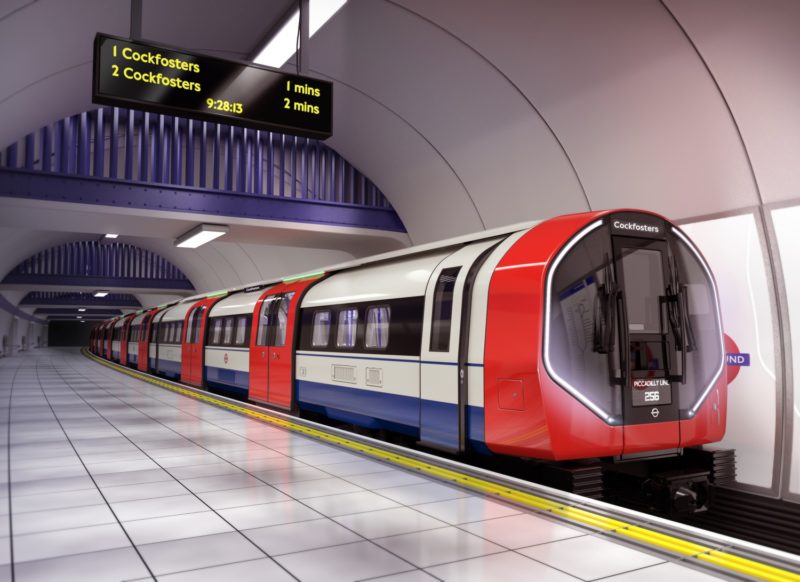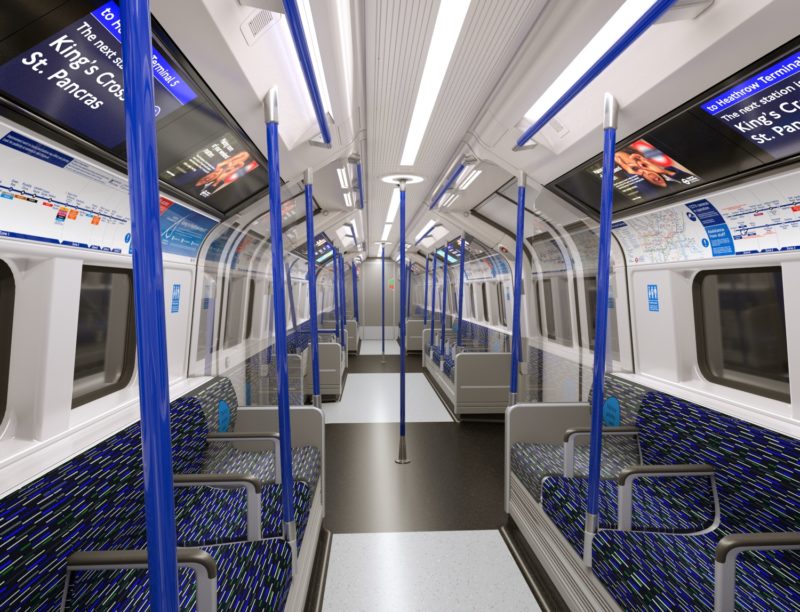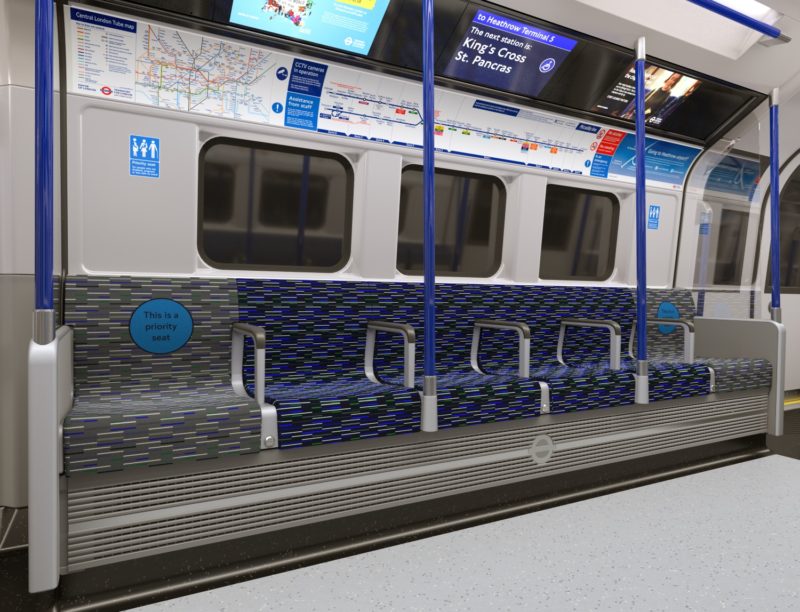Transport for London (TfL) and Siemens Mobility has unveiled the detailed design of the new generation Tube trains for the Piccadilly line.

The Inspiro London – or the New Piccadilly Line train – Image, Siemens Mobility/TfL
These trains will replace the existing trains which entered service in the 1970s. The move comes whilst TfL is suffering from lower revenue from the pandemic.
The new Siemens trains (Inspiro London) will start replacing the old 1973 stock (built by Metro-Cammell between 1974 and 1977, and were refurbished by Bombardier between 1996 and 2001) from 2025.
94 units, made up of nine carriages will be built. At peak capacity, they will be able to hold 1076 passengers on a train.
As the new trains are introduced to the Piccadilly Line, the current fleet will be gradually withdrawn from passenger service and the frequency of trains in peak hours will rise from 24 to 27 trains per hour from mid-2027. This will mean that is a train will depart every 135 seconds at the busiest times and represents a 23% increase in peak service capacity.
What’s new?
The new Tube trains will have wider doors and longer, walk-through, air-conditioned carriages for more comfortable journeys.
They will be optimised to have an extra 10% more capacity, as well as being significantly lighter than existing designs, meaning energy efficiency is increased and damage to tracks is reduced.
This will be achieved by using an innovative articulated design, meaning fewer bogies (the structures containing the wheels, motors and suspension to support and power the train) are required per full-length train. This provides the additional benefit of a smoother ride.
Construction
50% of the new fleet will be built in Goole, East Yorkshire, employing up to 700 people in engineering and manufacturing roles, 250 in the construction phase and 1,700 in the broader supply chain.
The order for the new Piccadilly line trains, together with a further investment in signalling which has not yet been funded, would support 25,000 new jobs in the capital, as well as supporting the next generation of transport workers through apprenticeship places created by Siemens Mobility, TfL and the wider supply chain.
In Quotes
Mayor of London, Sadiq Khan, said:
‘These much-needed new trains will be a great step forward for our city, improving frequency, reliability and capacity on the Piccadilly line.
‘The continued modernisation of the Tube – which has seen a transformation over the last two decades – is a key part of my Transport Strategy to make London a greener, more affordable, more accessible place. But we need investment to continue this work.
‘I will keep lobbying the Government to deliver a long-term, viable funding model for TfL, which would enable us to carry out more upgrades to the network’s ageing infrastructure, boost our economy and deliver a green recovery for London and the wider country.’
Andy Lord, Managing Director of London Underground, said:
‘The introduction of new, desperately-needed modern and reliable trains on the Piccadilly line, and the capacity they will provide, will be a boost for the capital.
‘We’re pleased that our investment in new trains is helping the UK economy and assisting with the recovery from the pandemic, and we look forward to seeing them on the network in years to come.
‘Sustained long-term investment would enable us to introduce more modern trains over time to replace other ageing fleets alongside new signalling, improving the journeys of millions more customers and reducing the costs of running the Tube.’
William Wilson, CEO of Siemens Mobility Limited, added:
‘The state-of-the-art trains will transform the Piccadilly line passenger experience.
‘They are lighter, more environmentally-friendly and future-proofed for a long life. But the benefits are not just confined to London. Building the new trains creates new UK jobs and extensive supply chain opportunities. A great example of levelling up in action.’
Steps to replace Deep-Level Trains
There are a lot more trains to replace after the Piccadilly Line, notably the Central Line (which had new trains delivered between 1991 – 1994), The Waterloo and City Line (which use a variant of the trains used on the Central Line) and the Bakerloo Line (which were introduced 1972–1974, making them the oldest trains on London Underground and the oldest trains in regular passenger use).
With a combination of new trains and upgraded signalling, these could offer some big benefits to Londoners who don’t like hanging around waiting for the next train.
How the trains and the rest of the programme will be funded will be an argument to be had between Transport for London, Her Majesties Government of the day and of course, the farebox revenue collected.
With reduced traffic due to the pandemic, this could be the real challenge for the upgrade programmes.
Welcome to Economy Class and Beyond – Your no-nonsense guide to network news, honest reviews, with in-depth coverage, unique research, as well as the humour and madness as I only know how to deliver.
Follow me on Twitter at @EconomyBeyond for the latest updates! You can follow me on Instagram too!
Also remember that we are part of the BoardingArea community, bringing you the latest frequent flyer news from around the world.


“The new Tube trains will have wider doors and longer, walk-through, air-conditioned carriages for more comfortable journeys.” .” REALLY? There has been so much contradiction with regards to the Cooling the Tube Project in the last 15 years, and the subject of AC on trains running on the Deep Tube Lines is just one of them!
LU/TfL’s cooling team, their consultants and academic advisers have always claimed that installing AC on the Deep Tube was not feasible because it would only serve to increase the heat load in the tunnel – and I agree. How then can they possible be specifying AC on these new deep tube line trains whilst not telling us how they are going to overcome that problem – the truth is that they are not going to overcome that problem, and they know it. This appears a “political” move to keep the travelling public excited about the possibility of a solution and, once more, when 2025 has arrived and gone, they will be sorely disappointed! The journals under the Railway Gazette International | Metro Report International | Rail Business UK group questions the thinking too – as follows:
“Hello
When the designs were presented to the media, Metro Report International – and a number of UK magazines – asked for clarification of what made air-conditioning now seem viable.
Unfortunately the people involved declined to answer. The nearest they came up was the suggestion that more energy-efficient trains would put less heat into the tunnels.
We do hope to follow this up in the future.”
All the LU/TfL’s cooling team, their consultants and academic advisers have recognised the seasonal nature of the problem and most of the press reports have also alluded to it, but no one has asked the questions: “why should this be?” and “what is the mechanism that is causing it?”
Andy Lord has known the answers since Christmas Eve 2019, but so far does not appear to have taken any action to deal these questions!